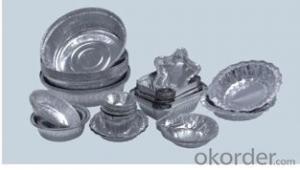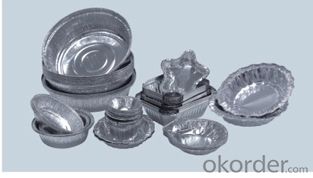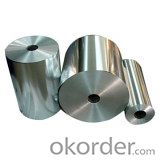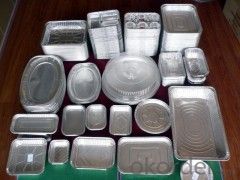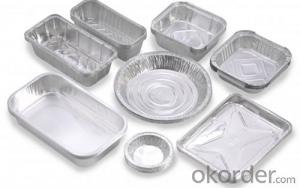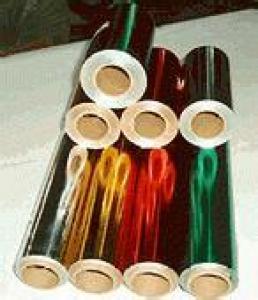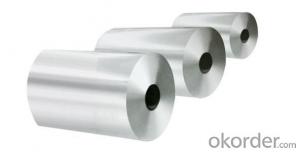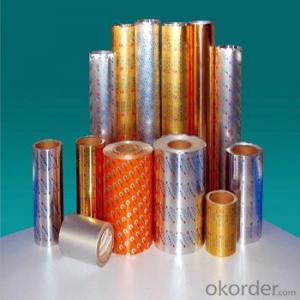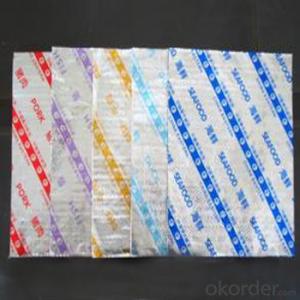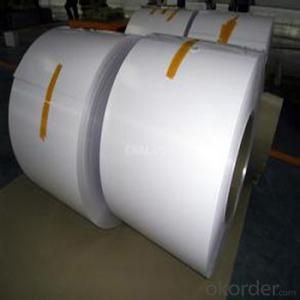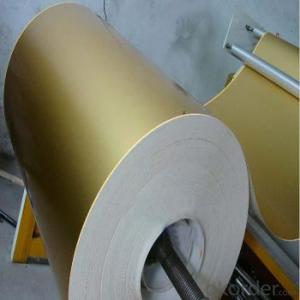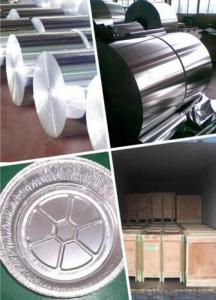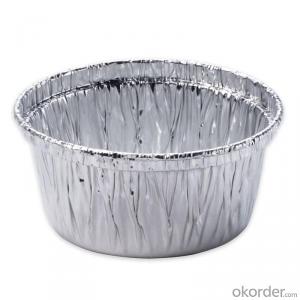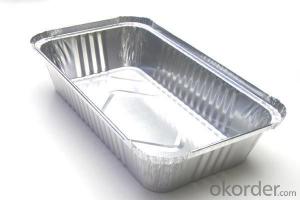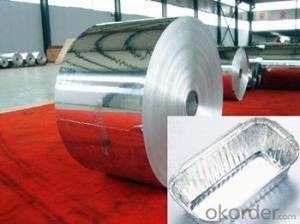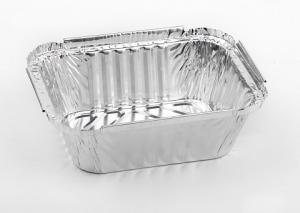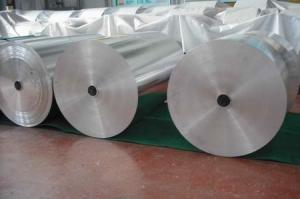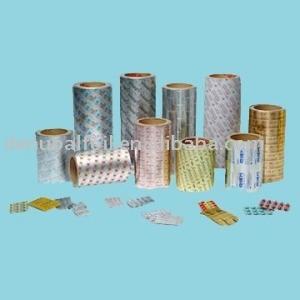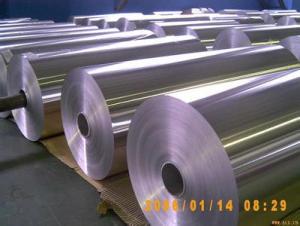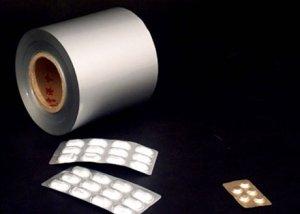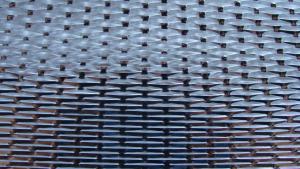8021 Aluminum Foil for Use Container
- Loading Port:
- China Main Port
- Payment Terms:
- TT OR LC
- Min Order Qty:
- -
- Supply Capability:
- -
OKorder Service Pledge
OKorder Financial Service
You Might Also Like
Aluminium foil acts as a total barrier to light and oxygen (which cause fats to oxidise or become rancid), odours and flavours, moistness, and germs, it is used broadly in food and pharmaceutical packaging. The purpose of aluminium is to make long-life packs (aseptic processing|aseptic packaging) for drinks and dairy goods, which allows storing without refrigeration. Aluminium foil containers and trays are used to bake pies and to pack takeaway meals, ready snacks and long life pet foods.
Aluminium foil is widely sold into the consumer market, often in rolls of 500 mm (20 in) width and several metres in length.It is used for wrapping food in order to preserve it, for example, when storing leftover food in a refrigerator (where it serves the additional purpose of preventing odour exchange), when taking sandwiches on a journey, or when selling some kinds of take-away or fast food. Tex-Mex restaurants in the United States, for example, typically provide take-away burritos wrapped in aluminium foil.
Aluminium foils thicker than 25 μm (1 mil) are impermeable to oxygen and water. Foils thinner than this become slightly permeable due to minute pinholes caused by the production process.
Aluminium foil has a shiny side and a matte side. The shiny side is produced when the aluminium is rolled during the final pass. It is difficult to produce rollers with a gap fine enough to cope with the foil gauge, therefore, for the final pass, two sheets are rolled at the same time, doubling the thickness of the gauge at entry to the rollers. When the sheets are later separated, the inside surface is dull, and the outside surface is shiny. This difference in the finish has led to the perception that favouring a side has an effect when cooking. While many believe that the different properties keep heat out when wrapped with the shiny finish facing out, and keep heat in with the shiny finish facing inwards, the actual difference is imperceptible without instrumentation.The reflectivity of bright aluminium foil is 88% while dull embossed foil is about 80%.
We provide a full range of precision aluminum strip for almost any application. We produce aluminum strip in a wide variety of alloys, including clad composites. Our aluminum strip can be produced in standard dimensions or custom made to your special requirements. We produce both imperial and metric units. We manufacture in compliance with the main international specifications, and tighter tolerances or custom tempers are available upon request. We offer various surface conditions, custom finishes (painting, anodizing, embossing), special processing, and multiple packaging options to meet our customer's unique requirements. The following is a summary of our capabilities.
Manufactured in compliance with the main international specifications and standards, including: Aluminum Association, ASTM, EN, and DIN.
We can also manufacture in compliance with other international standards including:ASME, SAE, AMS, AWS, FED, MIL, QQ, ISO, BS, AFNOR, JIS and GOST.
Manufactured in compliance with the main international specifications and standards.
Tighter tolerances are available upon request.
Aluminium (or aluminum; see spelling differences) is a chemical element in the boron group with symbol Al and atomic number 13. It is a silvery white, soft, ductile metal. Aluminium is the third most abundant element (after oxygen and silicon), and the most abundant metal in the Earth's crust. It makes up about 8% by weight of the Earth's solid surface. Aluminium metal is so chemically reactive that native specimens are rare and limited to extreme reducing environments. Instead, it is found combined in over 270 different minerals.The chief ore of aluminium is bauxite.
Aluminium is remarkable for the metal's low density and for its ability to resist corrosion due to the phenomenon of passivation. Structural components made from aluminium and its alloys are vital to the aerospace industry and are important in other areas of transportation and structural materials. The most useful compounds of aluminium, at least on a weight basis, are the oxides and sulfates.
Despite its prevalence in the environment, no known form of life uses aluminium salts metabolically. In keeping with its pervasiveness, aluminium is well tolerated by plants and animals. Owing to their prevalence, potential beneficial (or otherwise) biological roles of aluminium compounds are of continuing interest.
The earliest citation given in the Oxford English Dictionary for any word used as a name for this element is alumium, which British chemist and inventor Humphry Davy employed in 1808 for the metal he was trying to isolate electrolytically from the mineral alumina. The citation is from the journal Philosophical Transactions of the Royal Society of London: "Had I been so fortunate as to have obtained more certain evidences on this subject, and to have procured the metallic substances I was in search of, I should have proposed for them the names of silicium, alumium, zirconium, and glucium."
Davy settled on aluminum by the time he published his 1812 book Chemical Philosophy: "This substance appears to contain a peculiar metal, but as yet Aluminum has not been obtained in a perfectly free state, though alloys of it with other metalline substances have been procured sufficiently distinct to indicate the probable nature of alumina."[69] But the same year, an anonymous contributor to the Quarterly Review, a British political-literary journal, in a review of Davy's book, objected to aluminum and proposed the name aluminium, "for so we shall take the liberty of writing the word, in preference to aluminum, which has a less classical sound."
The -ium suffix conformed to the precedent set in other newly discovered elements of the time: potassium, sodium, magnesium, calcium, and strontium (all of which Davy isolated himself). Nevertheless, -um spellings for elements were not unknown at the time, as for example platinum, known to Europeans since the 16th century, molybdenum, discovered in 1778, and tantalum, discovered in 1802. The -um suffix is consistent with the universal spelling alumina for the oxide (as opposed to aluminia), as lanthana is the oxide of lanthanum, and magnesia, ceria, and thoria are the oxides of magnesium, cerium, and thorium respectively.
The aluminum spelling is used in the Webster's Dictionary of 1828. In his advertising handbill for his new electrolytic method of producing the metal in 1892, Charles Martin Hall used the -um spelling, despite his constant use of the -ium spelling in all the patents[58] he filed between 1886 and 1903. It has consequently been suggested[by whom?] that the spelling reflects an easier-to-pronounce word with one fewer syllable, or that the spelling on the flyer was a mistake.[citation needed] Hall's domination of production of the metal ensured that aluminum became the standard English spelling in North America.
- Q: okay, i'd like to settle this question - is aluminum cookware poisoness or harmful to our body? if so, why manufacturers still making them? i also noticed from many cook shows, most restaurant chefs cooking with the aluminum pans? please show me articles or scientific proof yes or no.
- Hear it is: www.laleva /environment/alumini... cyril
- Q: I made choclate layer cake with all frosting and all and I stored it in the fridge to eat it as and when I feel likeAfter about a day hours the cake turned out like hard chunk like its no longer spongy and softWhat went wrong how to avoid in future?
- Several things went wrong: 1Modern refrigerators cool via flowing airThe air dries out exposed items, such as uncovered cake, cut fruits or vegetables, or thin-skinned fruitCover your cake to prolong moistness2The frosting is likely to harden with the cold regardless of whether it is cooked (like fudge or fondant) or uncooked (like buttercream or cream-cheese icing), although for different reasons3The combination of cold and flowing air will make even covered cake go stale quickly (also bread in the original wrapper)How to avoid in future: 1If you're going to store cake that requires refrigeration (carrot cake with cream cheese frosting or fresh coconut cake), buy an air-tight cake safe designed for the purpose or bake the cake in a pan that came with an air-tight lid2Otherwise, don't refrigerate cake -Cut off what you can eat in a few days and keep it under glass or in an air-tight container at room temperature -Cut the rest into similar sized segments, wrap them well (plastic film + aluminum foil + freezer bag with label or freezer wrap + airtight plastic carton), label with contents and date, and freeze3Bake smaller cakes and eat them quicklyOr bake 3 layers, freeze two of them, and cut the third in half to make a half layer cake.
- Q: Whats the recipie for the things u wrap egg rolls in?
- I just answered thus some where elseAn angel food cake pan.
- Q: I am making a grilled chicken wrap that also includes bacon, avocado and ranchWhat ingredients would be good to include in the marinade for the chicken so the taste pairs with the other flavors?
- You could always buy a regular jazzmaster and pull the frets out fill in the slots then lower the nut and bridge and voila fretlessor if you have extra money take it to a luther and have them put on a fretless board and set it up.
- Q: Why is the US government allowing the space shuttle program to die? We should build 3 new ones with updated materials technology and replace the aging fleetInstead - we're going back to capsules - little round aluminum cans that get shot into space on a the tip of a rocket and then have to parachute back to earth.Parachute.In the 21st century.How can the Orion be used for mass evacuations of the ISS, or carry large crews into space, or carry grouops of high paying tourists into space? Or go out and repair sattelites (like the Hubble last week)?I suggest that every concerned US citixen (and international space exploration enthusiast) get off thier butts and start letting the Whitehouse and Congress know we're not happy - before it's too late.In a couple of years we will be back to 1968 level space exploration.Great.
- Such a big differenve in gauge needs the pattern to be rewritten completelyMost patterns now give a block of each piece in the garment showing the finished measurementsKnitting a swatch with your chosen yarn to find the gauge with that yarn together with the block gives the data required to rewrite the pattern.
- Q: Which exhaust pipe would be better, in terms of performance, weight (I think it's quite obvious) and durabilityIs there actually any real difference in performance, in reference to the material used?
- there was something probably wrong with your eyes because you were tiredit's nothing paranormal.
- Q: 1Write the complete electron configuration for the carbon atom2Using the NOBLE GAS abbreviation rewrite the electron configuration for the carbon atomAnd how the hell do I figure this out on my own for future hw problems like this.
- you dont have to make a three digit number your weight loss goal aim for a certain dress size or waist measurement
- Q: Every time I cook it, the edges burn to a crisp, I follow the instructions last time I even used quot;convect bakequot;, it still burned!I have to cook one for a party on Friday, If I thaw it out then cook it at a lower temp., but for longer, would that help? Or would it just dry out? Please any advice would help!
- In a baking dish put in two cans of cambells Golden mushroom soup with two and a half cups water and the chickenAlso put in some carrots and celeryPeel and boil some potatoes and use the soup after the chicken is done cooking for gravyYou won't even need anything to mix with it for the gravy its already to go and its yummyBake for about 45 minutes at 325-350 degrees.
- Q: I have an aluminum boat and need to bolt a stainless steel trim tab to it below the water lineI was told these metals are not compatible and must not make direct contact with each otherAny suggestions as to not allow these metals to touch? I'm thinking a rubber gasket or maybe a specialty paintWhat type metal for the 3/16 quot; machine screws would you recommend? Thanks.
- Yes if you have a cookie sheet why would you waste the aluminum foil?
Send your message to us
8021 Aluminum Foil for Use Container
- Loading Port:
- China Main Port
- Payment Terms:
- TT OR LC
- Min Order Qty:
- -
- Supply Capability:
- -
OKorder Service Pledge
OKorder Financial Service
Similar products
Hot products
Hot Searches
Related keywords
